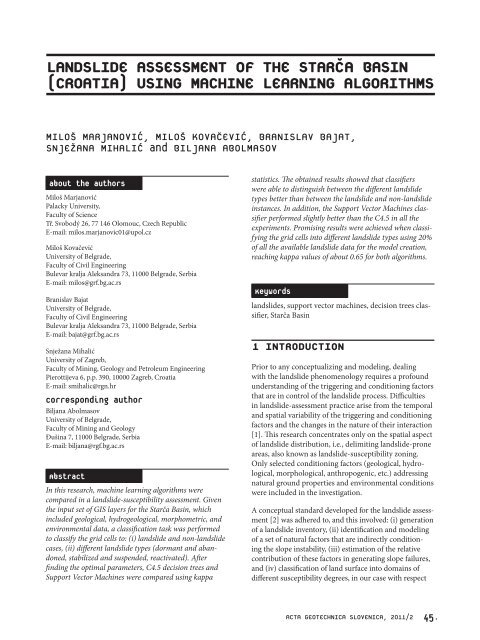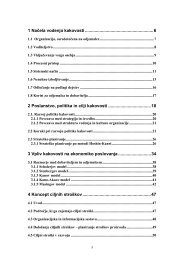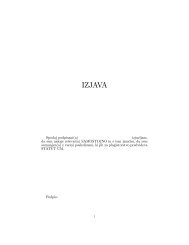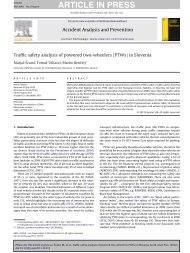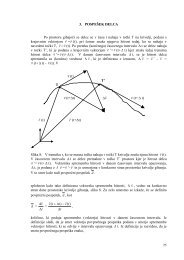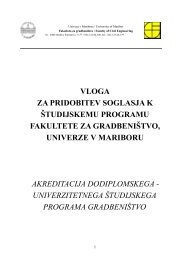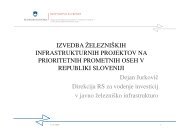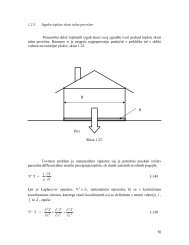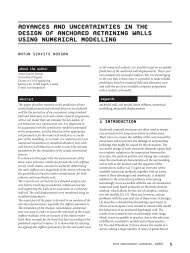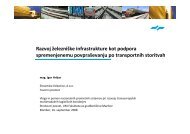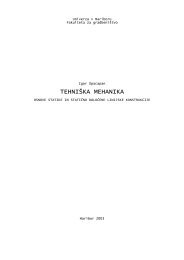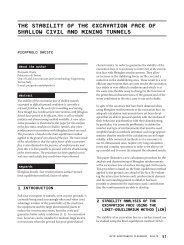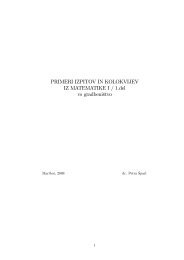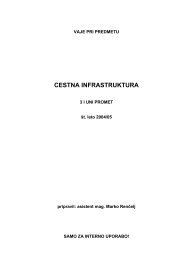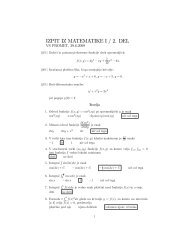LANDSLIDE ASSESSMENT OF THE STARCˇA BASIN (CROATIA ...
LANDSLIDE ASSESSMENT OF THE STARCˇA BASIN (CROATIA ...
LANDSLIDE ASSESSMENT OF THE STARCˇA BASIN (CROATIA ...
Create successful ePaper yourself
Turn your PDF publications into a flip-book with our unique Google optimized e-Paper software.
<strong>LANDSLIDE</strong> <strong>ASSESSMENT</strong> <strong>OF</strong> <strong>THE</strong> STARČA <strong>BASIN</strong><br />
(<strong>CROATIA</strong>) USING MACHINE LEARNING ALGORITHMS<br />
MILOS ˘ MARJANOVIC, ´ MILOS ˘ KOVACEVIC, ˘ ´ BRANISLAV BAJAT,<br />
SNJEZANA ˘<br />
MIHALIC ´ and BILJANA ABOLMASOV<br />
about the authors<br />
Miloš Marjanović<br />
Palacky University,<br />
Faculty of Science<br />
Tř. Svobodý 26, 77 146 Olomouc, Czech Republic<br />
E-mail: milos.marjanovic01@upol.cz<br />
Miloš Kovačević<br />
University of Belgrade,<br />
Faculty of Civil Engineering<br />
Bulevar kralja Aleksandra 73, 11000 Belgrade, Serbia<br />
E-mail: milos@grf.bg.ac.rs<br />
Branislav Bajat<br />
University of Belgrade,<br />
Faculty of Civil Engineering<br />
Bulevar kralja Aleksandra 73, 11000 Belgrade, Serbia<br />
E-mail: bajat@grf.bg.ac.rs<br />
Snježana Mihalić<br />
University of Zagreb,<br />
Faculty of Mining, Geology and Petroleum Engineering<br />
Pierottijeva 6, p.p. 390, 10000 Zagreb, Croatia<br />
E-mail: smihalic@rgn.hr<br />
corresponding author<br />
Biljana Abolmasov<br />
University of Belgrade,<br />
Faculty of Mining and Geology<br />
Đušina 7, 11000 Belgrade, Serbia<br />
E-mail: biljana@rgf.bg.ac.rs<br />
Abstract<br />
In this research, machine learning algorithms were<br />
compared in a landslide-susceptibility assessment. Given<br />
the input set of GIS layers for the Starča Basin, which<br />
included geological, hydrogeological, morphometric, and<br />
environmental data, a classification task was performed<br />
to classify the grid cells to: (i) landslide and non-landslide<br />
cases, (ii) different landslide types (dormant and abandoned,<br />
stabilized and suspended, reactivated). After<br />
finding the optimal parameters, C4.5 decision trees and<br />
Support Vector Machines were compared using kappa<br />
statistics. The obtained results showed that classifiers<br />
were able to distinguish between the different landslide<br />
types better than between the landslide and non-landslide<br />
instances. In addition, the Support Vector Machines classifier<br />
performed slightly better than the C4.5 in all the<br />
experiments. Promising results were achieved when classifying<br />
the grid cells into different landslide types using 20%<br />
of all the available landslide data for the model creation,<br />
reaching kappa values of about 0.65 for both algorithms.<br />
Keywords<br />
landslides, support vector machines, decision trees classifier,<br />
Starča Basin<br />
1 INTRODUCTION<br />
Prior to any conceptualizing and modeling, dealing<br />
with the landslide phenomenology requires a profound<br />
understanding of the triggering and conditioning factors<br />
that are in control of the landslide process. Difficulties<br />
in landslide-assessment practice arise from the temporal<br />
and spatial variability of the triggering and conditioning<br />
factors and the changes in the nature of their interaction<br />
[1]. This research concentrates only on the spatial aspect<br />
of landslide distribution, i.e., delimiting landslide-prone<br />
areas, also known as landslide-susceptibility zoning.<br />
Only selected conditioning factors (geological, hydrological,<br />
morphological, anthropogenic, etc.) addressing<br />
natural ground properties and environmental conditions<br />
were included in the investigation.<br />
A conceptual standard developed for the landslide assessment<br />
[2] was adhered to, and this involved: (i) generation<br />
of a landslide inventory, (ii) identification and modeling<br />
of a set of natural factors that are indirectly conditioning<br />
the slope instability, (iii) estimation of the relative<br />
contribution of these factors in generating slope failures,<br />
and (iv) classification of land surface into domains of<br />
different susceptibility degrees, in our case with respect<br />
ACTA GEOTECHNICA SLOVENICA, 2011/2 45.
M. MARJANOVIĆ ET AL.: <strong>LANDSLIDE</strong> <strong>ASSESSMENT</strong> <strong>OF</strong> <strong>THE</strong> STAR˘CA <strong>BASIN</strong> (<strong>CROATIA</strong>) USING MACHINE LEARNING ALGORITHMS<br />
to (i). The essential idea behind it suggests that if there<br />
were landslide occurrences under certain conditions<br />
in the past, it is quite likely that a similar association of<br />
conditions will lead to new occurrences [2]. The estimation<br />
of the relative contribution of a factor in the overall<br />
stability (iii) (which herein comes down to a classification<br />
problem) ranges over a broad variety of methods [3].<br />
These include the Analytical Hierarchy Process (AHP)<br />
[4], conditional probability [5], discriminant analysis [6],<br />
different kinds of regression models [7], Fuzzy Logics [8],<br />
Support Vector Machines (SVMs) [9], Artificial Neural<br />
Networks (ANNs) [10] and decision trees [11]. Relatively<br />
few researchers have dealt with the machine learning<br />
approach, but recently it is getting more popular in geoscientific<br />
communities, especially for comparative studies<br />
of landslide susceptibility [12], [13].<br />
Following such a trend, we herein utilized C4.5 decision<br />
trees and SVM algorithms for mapping landslides and<br />
distinguishing between different landslide categories.<br />
Thus far, researchers did not experiment with multiclass<br />
classifications (usually binary classification case<br />
studies can be found in the literature) and here we challenged<br />
the classification in that context. The theoretical<br />
advantages of the chosen machine learning approaches<br />
are numerous, particularly regarding the handling of<br />
data with different scales and types, independence from<br />
statistical distribution assumptions (the drawbacks of<br />
regression and discriminant methods) and so forth [14],<br />
which was also one of the motifs for its implementation<br />
in present research.<br />
The proposed model might serve for a landslidesusceptibility<br />
assessment in other areas of the City of<br />
Zagreb, under the assumption of similar terrain properties,<br />
primarily geological ones. These are urbanized and<br />
densely populated areas, hence less explorative for the<br />
field investigation of landslides. In such circumstances,<br />
the presented approach might lead to certain benefits,<br />
but more detailed investigations are needed to obtain<br />
reliable results. The latter involves testing the model<br />
against several pilot areas and tracking its performance.<br />
The biggest obstacle to the completion of that goal is a<br />
lack of detailed landslide inventories at the moment.<br />
2 METHODS<br />
The different stages of research called for different<br />
procedures, imposing a variety of methods, including<br />
the pre-processing of input attributes, machine learning<br />
implementation, and performance evaluation. All the<br />
related machine learning experiments and the subsequent<br />
algorithm-performance evaluation were placed in<br />
an open-source package, Weka 3.6 [15].<br />
46. ACTA GEOTECHNICA SLOVENICA, 2011/2<br />
Assuming that our inputs are organized as raster sets<br />
where each grid element (pixel) represents a data instance<br />
at a certain point of the terrain, our approach leads to a<br />
classification task that places each pixel from any terrain<br />
attribute raster into an appropriate landslide category<br />
associated with that particular pixel. We will herein<br />
explain the classification problem and machine learning<br />
solution in depth, and from the perspective of their particular<br />
application in landslide-susceptibility assessment.<br />
2.1 PROBLEM FORMULATION<br />
Let P={x|xÎR n } be a set of all the possible pixels extracted<br />
from the raster representation of a given terrain. Each<br />
pixel is represented as an n-dimensional real vector<br />
where the coordinate x i represents a value of the i-th<br />
terrain attribute associated with the pixel x. Further, let<br />
C={c 1,c 2,…,c l} be a set of l disjunctive, predefined landslide<br />
categories (j=1,l). A function ¦ c:P→C is called a classification<br />
if for each x iÎP it holds that ¦ c(x i)=j whenever<br />
a pixel x i belongs to the landslide category c j. In practice,<br />
for a given terrain, one has a limited set of m-labeled<br />
examples (i=1,m) which form a training set (x i, c i), x iÎR n ,<br />
c iÎC, i=1,…,m (m being a reasonably small number of<br />
instances). The machine learning approach tries to find a<br />
decision function ¦ c’ which is a good approximation of a<br />
real, unknown function ¦ c , using only the examples from<br />
the training set and a specific learning method [16].<br />
2.2 SUPPORT VECTOR MACHINES CLAS-<br />
SIFIER<br />
Originally, a SVM is a linear binary classifier (instances<br />
could be classified to only one of the two classes), but<br />
one can easily transform an n-classes problem into a<br />
sequence of n (one-versus-all) or n(n-1)/2 (one-versusone)<br />
binary classification tasks, where using different<br />
voting schemes leads to a final decision [17]. Given a<br />
binary training set (x i ,y i), x iÎR n , y iÎ {-1,1}, i=1,…,m, the<br />
basic variant of the SVM algorithm attempts to generate<br />
a separating hyper-plane in the original space of n coordinates<br />
(x i parameters in vector x) between two distinct<br />
classes (Fig. 1). During the training phase the algorithm<br />
seeks out a hyper-plane that best separates the samples of<br />
binary classes (classes 1 and –1). Let h 1: wx + b = 1 and<br />
h -1: wx + b = –1 (w,xÎR n , bÎR) be possible hyper-planes<br />
such that the majority of class 1 instances lie above h 1<br />
(wx + b > 1) and the majority of class –1 fall below h -1<br />
(wx + b < –1), whereas the elements belonging to h 1, h -1<br />
are defined as Support Vectors (Fig. 1). Finding another<br />
hyper-plane h: wx + b = 0 as the best separating (lying in<br />
the middle of h 1, h -1), assumes calculating w and b, i.e.,<br />
solving the nonlinear convex programming problem.
The notion of the best separation can be formulated as<br />
finding the maximum margin M between the two classes.<br />
Since M = 2w -1 maximizing the margin leads to the<br />
constrained optimization problem of Eq. (1).<br />
1<br />
min<br />
w,<br />
b 2<br />
M. MARJANOVIĆ ET AL.: <strong>LANDSLIDE</strong> <strong>ASSESSMENT</strong> <strong>OF</strong> <strong>THE</strong> STAR˘CA <strong>BASIN</strong> (<strong>CROATIA</strong>) USING MACHINE LEARNING ALGORITHMS<br />
w<br />
2<br />
+ Cåe i<br />
i<br />
(1)<br />
w.r.t: 1 -e -y ( w⋅ x + b) £ 0, - e £ 0, i= 1,2,... m<br />
i i i i<br />
Despite having some of the instances misclassified (Fig.<br />
1) it is still possible to balance between the incorrectly<br />
classified instances and the width of the separating<br />
margin. In this context, the positive slack variables ε i and<br />
the penalty parameter C are introduced. Slacks represent<br />
the distances of the misclassified points to the initial<br />
hyper-plane, while parameter C models the penalty for<br />
misclassified training points, that trades-off the margin<br />
size for the number of erroneous classifications (the<br />
bigger the C the smaller the number of misclassifications<br />
and the smaller the margin). The goal is to find a<br />
hyper-plane that minimizes the misclassification errors<br />
while maximizing the margin between classes. This<br />
optimization problem is usually solved in its dual form<br />
(dual space of Lagrange multipliers):<br />
* m<br />
= a y , C 0, i 1,... m<br />
i 1<br />
i i i<br />
³ a<br />
i<br />
³ =<br />
å w x , (2)<br />
=<br />
where w* is a linear combination of training examples<br />
for an optimal hyper-plane.<br />
However, it can be shown that w* represents a linear<br />
combination of Support Vectors x i for which the<br />
corresponding α i Langrangian multipliers are non-zero<br />
values. Support Vectors for which the C > α i > 0 condi-<br />
Figure 1. General binary classification case (h 0: wx+b=0;<br />
h 1: wx+b=1; h 2: wx+b=-1). Shaded points represent misclassified<br />
instances.<br />
tion holds, belong either to h 1 or h -1. Let x a and x b be<br />
two such Support Vectors (C > α a, α b > 0) for which<br />
y a = 1 and y b = –1. Now b could be calculated from<br />
b* = –0.5w*(x a + x b), so that the classification (decision)<br />
function finally becomes:<br />
x =<br />
m<br />
åai<br />
i=<br />
1<br />
i xi⋅ x +<br />
*<br />
. (3)<br />
f( ) sgn y ( ) b<br />
In order to cope with non-linearity even further, one<br />
can propose the mapping of instances to a so-called<br />
feature space of very high dimension: ϕ:R n →R d , n
M. MARJANOVIĆ ET AL.: <strong>LANDSLIDE</strong> <strong>ASSESSMENT</strong> <strong>OF</strong> <strong>THE</strong> STAR˘CA <strong>BASIN</strong> (<strong>CROATIA</strong>) USING MACHINE LEARNING ALGORITHMS<br />
the dataset. The interpretability of the derived model<br />
enables a domain expert to have a better understanding<br />
of the problem and in many cases could be preferable to<br />
functional models such as SVMs.<br />
Let us briefly explain how the tree can be derived from<br />
the training data (x i ,c i), i=1,…,m, where c i is one of k<br />
disjunctive classes. C4.5 deals both with numerical and<br />
categorical attributes, but for the sake of simplicity we first<br />
made an assumption that all attributes are categorical.<br />
The tree construction process performs a greedy search in<br />
the space of all possible trees starting from the empty tree<br />
and adding new nodes in order to increase the classification<br />
accuracy on the training set. A new node (candidate<br />
attribute test) is added below a particular branch if the<br />
instances following the branch are partitioned after the<br />
test in such way that the distinction between the classes<br />
becomes more evident. If the test on attribute A splits the<br />
instances into subsets in which all elements have the same<br />
class labels that would be a perfect attribute choice (those<br />
subsets become leaf nodes). On the other hand, if the<br />
instances are distributed so that in each subset there are<br />
equal numbers of elements belonging to different classes,<br />
then A would be the worst attribute choice. Hence, the<br />
root node should be tested against the most informative<br />
attribute concerning the whole training set. C4.5 uses the<br />
Gain Ratio measure [21] to choose between the available<br />
attributes and is heavily dependent on the notion of<br />
Entropy. Fig. 2 explains the calculation of Gain Ratio.<br />
Let Sin be the set of N instances for which the preceding<br />
test in the parent node forwarded them to the current<br />
node. Further, let ni be the number of instances from<br />
Sin that belong to class ci, i=1,...,k. The entropy E(Sin) is<br />
defined as a measure of impurity (with respect to the<br />
class label) of the set Sin as:<br />
k ni ni<br />
ES ( in ) =-å log2<br />
(6)<br />
N N<br />
i=<br />
1<br />
Figure 2. Calculating Gain Ratio of an attribute in the internal<br />
node of the growing tree.<br />
48. ACTA GEOTECHNICA SLOVENICA, 2011/2<br />
If all instances belong to the same class then the entropy<br />
is zero. On the other hand, if all classes are equally<br />
present, the entropy is a maximum (log 2k). In our<br />
problem the setting A denotes the candidate attribute<br />
of an instance x. Since by assumption A is categorical<br />
and can take n different values ν 1,ν 2,…,ν n , there are n<br />
branches leading from the current node. Each S out(A=ν i)<br />
represents the set of instances for which A takes the<br />
value ν i . The informative capacity of A concerning the<br />
classification into k predefined classes can be expressed<br />
by using the notion of Information Gain:<br />
S ( A= v)<br />
IG(S , A) = E(S ) - å E(S ( A = v))<br />
(7)<br />
out<br />
in in<br />
vÎ{ v1,..., vn}<br />
N<br />
out<br />
In Eq. (7) |S out(A=ν)| represents the number of instances<br />
in the set S out(A=ν) and E(S out(A=ν)) is the entropy of<br />
that set calculated using Eq. (6). The higher is the IG,<br />
the more informative is the A for the classification in the<br />
current node, and vice versa [14].<br />
The main disadvantage of the IG measure is that it favors<br />
attributes with many values over those with fewer. This<br />
leads to wide trees with many branches starting from<br />
corresponding nodes. If the tree is complex and has a<br />
lot of leaf nodes, then it is expected that the model will<br />
overfit the data (it will learn the anomalies of the training<br />
data and its generalization capacity, i.e., the classification<br />
accuracy on unseen instances, will be decreased).<br />
In order to reduce the effect of overfitting C4.5 further<br />
normalizes IG by the entropy calculated with respect to<br />
the attribute values instead of class labels (Split Information)<br />
to obtain the Gain Ratio (GR):<br />
S out ( A= v) S out ( A= v)<br />
SI(S in , A)<br />
=- å log 2<br />
vÎ{ v1,... vn}<br />
N N<br />
,<br />
IG(S in , A)<br />
GR(S in , A)<br />
=<br />
SI(S , A)<br />
(8)<br />
C4.5 uses GR to drive the greedy search over all possible<br />
trees. If the attribute is numerical (this is the case for<br />
most attributes in our application) C4.5 detects the<br />
candidate thresholds that separate the instances into<br />
different classes. Let (A, c i) pairs be (50, 0), (60, 1), (70,1)<br />
(80,1), (90,0) ,(100,0). C4.5 identifies two thresholds on<br />
the boundaries of different classes: A
M. MARJANOVIĆ ET AL.: <strong>LANDSLIDE</strong> <strong>ASSESSMENT</strong> <strong>OF</strong> <strong>THE</strong> STAR˘CA <strong>BASIN</strong> (<strong>CROATIA</strong>) USING MACHINE LEARNING ALGORITHMS<br />
well as possible (overfitted model) it converts the tree into<br />
a set of equivalent rules, one rule of the form if A=v and<br />
B
M. MARJANOVIĆ ET AL.: <strong>LANDSLIDE</strong> <strong>ASSESSMENT</strong> <strong>OF</strong> <strong>THE</strong> STAR˘CA <strong>BASIN</strong> (<strong>CROATIA</strong>) USING MACHINE LEARNING ALGORITHMS<br />
border of the City of Zagreb, Croatia (Fig. 3). This area<br />
is composed of the Upper Miocene and Plio-Quaternary<br />
sediments. The ground conditions, morphological<br />
settings and urbanization of the area could be considered<br />
as the primary causal factors for numerous shallow<br />
and relatively small landslides triggered by physical (e.g.,<br />
intense, short period rainfall) or man-made processes.<br />
The resources for generating the input dataset of the<br />
Starča Basin included: landslide inventory; Digital Terrain<br />
Model (DTM); geological map; hydrogeological map; and<br />
a land-cover map. From the above-mentioned resources,<br />
the input dataset was generated as an assembly of attributes.<br />
Using the advantages of GIS software platforms<br />
(ArcGIS and SagaGIS) the input data were processed,<br />
i.e., referenced and normalized (where applicable) and<br />
stored in a raster image format so that every pixel (every<br />
center node of the pixel to be more exact) represents<br />
one instance. Every attribute within the input dataset<br />
contained 122513 instances with a 10-m cell resolution.<br />
3.1 <strong>LANDSLIDE</strong> INVENTORY<br />
A detailed geomorphological landslide map was<br />
prepared through a systematic field survey (in the period<br />
of March–April 2004) at 1:5000 scale (Fig. 4). The total<br />
mapped landslide area reached only 0.87 km 2 (or 7.1% of<br />
the study area, which is statistically speaking, an undesirable<br />
proportion), with a density of about 0.1 slope<br />
failures per km 2 . The landslide inventory was prepared<br />
in the form of a GIS database in which information on<br />
the location, features and abundance of 230 mapped<br />
landslides is archived [26]. The main landslide characteristics<br />
were described according to standard WP/WLI<br />
(1993) recommendations [27]. Landslides were classified<br />
as (shallow) slide type according to Cruden and Varnes<br />
Classification [28], with the age and state of activity<br />
determined according to the morphological indicators.<br />
Active, suspended and reactivated landslides have clearly<br />
recognizable fresh scars, without any vegetation cover,<br />
because of movement within the past few years (59<br />
slides). Most of the landslides are inactive and they are<br />
classified as: dormant landslides (95 slides) have recognizable<br />
scars covered by vegetation during the period of<br />
inactivity; abandoned landslides (72 slides) are characterised<br />
by a hummocky surface topography and relics of<br />
scars completely smoothed during the period of inactivity;<br />
and stabilized landslides included those mitigated<br />
by engineering measures (4 slides). Relict landslides (40<br />
slides) are difficult to recognize, because the only indicator<br />
of movement is a typical roughly undulating slope<br />
morphology: concave depletion zone in the upper part<br />
and convex accumulation zone in the lower part.<br />
50. ACTA GEOTECHNICA SLOVENICA, 2011/2<br />
a)<br />
b)<br />
Figure 4. a) Landslide distribution in the basin area, b)<br />
Enlargement of a geomorphological landslide map, original<br />
scale 1:5000.<br />
The size of the landslides varies from 270 m 2 to 25.073<br />
m 2 . Most of the landslides range in size from 400 m 2 to<br />
1600 m 2 . Regarding activity style, there are single movements<br />
(150 slides) as well as complex, composite, successive<br />
and multiple movements (120 slides). ‘Parent-child’<br />
relationships were also defined during the mapping.<br />
The relict slides are excluded from any further analysis<br />
because of the mapping uncertainty.<br />
For the purpose of this research, the landslide inventory<br />
is used only in a raster-image form. The landslide<br />
inventory was somewhat simplified for the purpose of<br />
this research in order to enhance the statistical representativeness<br />
of the categories (the merging of the original<br />
categories was based on the activity stage).
3.2 CONDITIONING FACTORS – TERRAIN<br />
ATTRIBUTES<br />
The landslide-conditioning factors involved a variety<br />
of input layers, some being directly digitized from the<br />
original thematic maps, others derived from additional<br />
spatial calculations and modeling. In effect, 15 inputraster<br />
layers, with the same 10 m cell resolution, were<br />
available for further analysis. These could be divided<br />
into three thematic groups: geological, morphological,<br />
and environmental factors. Note also that the factors<br />
that turned more dominant in this research are somewhat<br />
detailed in the description.<br />
Geological factors included layers derived from the 1:5000<br />
geological map, indicating the main geological units in the<br />
area and the approximately located faults [29]:<br />
a)<br />
M. MARJANOVIĆ ET AL.: <strong>LANDSLIDE</strong> <strong>ASSESSMENT</strong> <strong>OF</strong> <strong>THE</strong> STAR˘CA <strong>BASIN</strong> (<strong>CROATIA</strong>) USING MACHINE LEARNING ALGORITHMS<br />
b) c)<br />
– Lithology (representing 10 rock units as categorical<br />
classes 1 ) Eight main lithological types can be distinguished<br />
(Fig. 5a): eluvial clay and silty clay with<br />
gravel (Quatenary), alluvial gravel with silty clay<br />
(Quaternary), gravel with silty clay (Plio-Pleistocene),<br />
coarse-grained sand (Plio-Pleistocene), sandy<br />
silt and silt (Pontian), marl with silt and calcareous<br />
siltstone (Pannonian), laminated marl with calcareous<br />
sandstone (Sarmatian) and marl (Badenian).<br />
Considering the relatively high proportion of clayey<br />
and marly units, the lithological model suggests that<br />
shallow to deep-seated landslides could be hosted on<br />
a significant part of the area (Fig. 5a)<br />
– Proximity to the fault lines<br />
A high precision terrain surface model (±1 m) was<br />
developed through the photogrammetric technique, in<br />
Figure 5. a) Attribute lithological units with the breakdown of the percentage proportion of unit groups,<br />
b) Attribute channel network base levels, c) Attribute altitude above channel network;<br />
Note that the selection of these three thematic layers corresponds with the three most important attributes in Table 2.<br />
1 The categorical attributes were extended into n binary attributes, coding n different initial values (e.g., class 1 and 4 of Lithology are coded as<br />
1000000000 and 0001000000, respectively, while the same classes for Land Use were 1000 and 0001), in order to give equal preference to every class.<br />
ACTA GEOTECHNICA SLOVENICA, 2011/2 51.
M. MARJANOVIĆ ET AL.: <strong>LANDSLIDE</strong> <strong>ASSESSMENT</strong> <strong>OF</strong> <strong>THE</strong> STAR˘CA <strong>BASIN</strong> (<strong>CROATIA</strong>) USING MACHINE LEARNING ALGORITHMS<br />
the framework of orthophotomaps production of the<br />
Zagreb City area, at a scale of 1:5000. The terrain model<br />
was subsequently transformed to a DTM by means of<br />
vector-to-raster conversion. A host of morphometric<br />
parameters with a proven relevance for landslide assessment<br />
[30] were derived from the DTM:<br />
– Slope<br />
– Downslope gradient (ratio of the slope angle and the<br />
elevation)<br />
– Aspect<br />
– Profile Curvature (terrain curvature in the steepest<br />
slope direction)<br />
– Plan Curvature (terrain curvature along the contour)<br />
– Convergence Index (slope angle convergence)<br />
– LS factor (ratio of the slope length and the length<br />
standardized by the Universal Soil Loss Equation)<br />
– Channel network base level elevations are values<br />
calculated as a vertical difference between the real<br />
DTM elevations and the elevations of the (interpolated)<br />
channel network (Fig. 5b). It provides information<br />
on how far each cell is from the local flow, just<br />
by interpreting the higher differences as more remote<br />
than the lower ones (in channel cells the attribute’s<br />
value is zero, while in non-channel cells the value is<br />
increasing with the distance from the flow)<br />
– Altitude above the channel network is another standard<br />
morphometric terrain attribute, yet sometimes<br />
important to determine the relief energy based on<br />
potential energy differences (height differences)<br />
between each cell and its local erosional basis (Fig.<br />
5c). It is basically a DTM downshifted by the value of<br />
the channel cells elevations.<br />
– Stream Power Index (potential power of the flows<br />
given by a relation of the local drainage area and the<br />
local slope gradient)<br />
– Topographic Wetness Index (topographic water<br />
retention potential given by a relation of the upslope<br />
drainage area and the slope gradient)<br />
Piezometric map, an interpolation of the maximum<br />
piezometric pressure heads, measured in a rainy period<br />
of 2004, was used to generate the attribute:<br />
– Groundwater table depth (depths from the measurements<br />
of the minimal water levels in wells, interpolated<br />
by the nearest-neighbor method, ranged by 4<br />
classes with 0.5 m intervals, i.e., 0–0.5, 0.5–1, 1–1.5<br />
and >1.5 m)<br />
The Land Use map was prepared by a direct visual<br />
interpretation of a 1:5000 orthophoto according to the<br />
CORINE classification. The map was generalized as the<br />
attribute:<br />
52. ACTA GEOTECHNICA SLOVENICA, 2011/2<br />
– Land Use (a categorical attribute with 4 thematic<br />
classes, similarly arranged as in the case of Lithology.<br />
The classes included: Agricultural areas 30%, Artificial<br />
surfaces 4%, Forests and semi-natural areas 65%,<br />
Water bodies 1%)<br />
4 RESULTS AND DISCUSSION<br />
The experimental design was governed by the characteristics<br />
of the dataset, particularly the unbalanced distribution<br />
of the landslide inventory classes. Since the non-landslide<br />
class turned out to be predominant over all the landslide<br />
classes combined, the sampling strategy was tuned accordingly.<br />
Two different dataset cases were induced:<br />
– S01 with a binary class labels, i.e., class c 1 – absence of<br />
landslides, and class c 2 – presence of landslides (Fig.<br />
6a). It contained 20% of the original dataset (randomly<br />
selected), or 24500 out of 122513 instances.<br />
– S123 included only landslide instances (Fig. 6b) from<br />
the original dataset distributed in three different<br />
classes: c 1 – dormant and abandoned, c 2 – stabilized<br />
and suspended, and c 3 – reactivated landslides (a<br />
total of 10500 instances).<br />
Thus, the classifier trained by the first set was used to<br />
locate the landslides throughout the area, while the<br />
classifier trained by the second set was used to discern<br />
between three landslide types. In this way, featured<br />
expert judgment is simulated and could be applied to the<br />
remaining part of the terrain, as well as to the adjacent<br />
ground. Both sets passed through the identical experimenting<br />
protocol discussed subsequently.<br />
For the C4.5 algorithm we used the default parameters<br />
of Weka explorer: 0.25 for confidence level for pruning,<br />
while the minimum number of objects in leaf was held<br />
at 2. The optimization of SVM also comes down to the<br />
fitting of only two parameters: the margin penalty C and<br />
the kernel width γ. The parameters are found in a wellestablished<br />
cross-validation procedure 2 over the training<br />
set in each performed experiment [31], [32]. It turns out<br />
that the optimal parameters (C=100, γ=4) are the same<br />
for all the performed experiments.<br />
– Experiment#1: testing was performed on S01 (24500<br />
instances) and S123 (10500 instances) data in a<br />
single run (no iterations), through 10-fold cross-validation<br />
(10-CV). The value of the representative κ was<br />
2 In k-fold cross-validation (k-CV), the entire set is partitioned<br />
into k disjoint splits of the same size. Validation is completed in k<br />
iterations, each time using a different split for the validation, and<br />
merging the remaining k-1 splits for training.
a)<br />
M. MARJANOVIĆ ET AL.: <strong>LANDSLIDE</strong> <strong>ASSESSMENT</strong> <strong>OF</strong> <strong>THE</strong> STAR˘CA <strong>BASIN</strong> (<strong>CROATIA</strong>) USING MACHINE LEARNING ALGORITHMS<br />
Figure 6. a) Landslide inventory map for S01, b) Different landslide categories<br />
(dormant and abandoned 1, stabilized and suspended 2, reactivated 3) for S123.<br />
obtained directly after the cross-validation was run.<br />
For the C4.5 algorithm it reached 0.52 in the S01<br />
and 0.82 in the S123 data set. The SVM algorithm<br />
reached a very similar performance, i.e., a fraction<br />
higher in S01 (Table 1), meaning that it is somewhat<br />
more reliable in mapping landslides but equal in<br />
discerning between different types of landslides.<br />
– Experiment#2: Both sets were randomly divided<br />
into 20–80% splits. The training was performed on<br />
20% of the data (5000 instances in S01 and 2000<br />
instances in S123). In order to obtain statistically<br />
relevant results, five different 20–80% splits were<br />
generated and the median among the obtained κ<br />
values was considered as being representative (Table<br />
1). As expected, the performance drops significantly,<br />
especially in S01. It is also apparent that SVM is<br />
slightly better than the C4.5 in this set, while in S123<br />
the algorithms are leveled.<br />
– Experiment#3: generating seven 15–85% splits (3800<br />
instances in S01 and 1500 instances in S123 for training<br />
purposes), otherwise analogue to the previous. A<br />
further decrease of the average κ is noticeable, as well<br />
as a slightly advantageous performance of the SVM<br />
algorithm (Table 1).<br />
– Experiment#4: generating ten 10–90% splits (2500<br />
instances in S01 and 1000 instances in S123),<br />
otherwise analogous to the previous. The dropping<br />
trend continues, as κ values became rather temperate<br />
for both algorithms within both sets (Table 1).<br />
Viewing the experiment results altogether, a slight<br />
preference for the SVM over the C4.5 is obvious in both<br />
S01 and S123 data sets, due to the smaller κ decrements<br />
(0.03–0.05) with a reduction of the training sample size.<br />
b)<br />
Table 1. Performance evaluation of the C4.5 and SVM classifiers<br />
by κ-index.<br />
Experiment S01 S123<br />
C4.5 SVM C4.5 SVM<br />
#1 (10–CV) 0.52 0.58 0.82 0.82<br />
#2 (5x20–80%) 0.38 0,47 0.63 0.65<br />
#3 (7x15–85%) 0.33 0.44 0.58 0.60<br />
#4 (10x10–90%) 0.31 0.40 0.48 0.55<br />
In all the experiments the algorithms exhibit a better<br />
generalization with the S123 set, meaning that they are<br />
better in categorizing landslides than actually mapping<br />
them, concerning the present study area and the chosen<br />
sampling strategy. Preliminary results suggest that using<br />
the same input attributes, it would be interesting to<br />
impose the algorithms over adjacent areas (which are<br />
urbanized, but have similar terrain features) in order to<br />
suggest to the expert which types of landslides are present<br />
prior to the real field mapping.<br />
Since we have been using a classifier based on information<br />
gain values (C4.5), we evaluated the ranking of the<br />
input features according to their IG values (Table 2). It<br />
appears that the most informative layers are Lithology,<br />
Channel Network Base Elevations, Altitude Above Channel<br />
Network, while surprisingly Slope turned out to be<br />
mediocre to low, hand in hand with the terrain Convergence<br />
Index and Land Use for instance. One possible<br />
way to explain this is an exaggeration of the geological<br />
and, to some extent, the hydrogeological influence on the<br />
landslide occurrence, so that they obscure the effects of<br />
slope steepness and land use for instance.<br />
ACTA GEOTECHNICA SLOVENICA, 2011/2 53.
M. MARJANOVIĆ ET AL.: <strong>LANDSLIDE</strong> <strong>ASSESSMENT</strong> <strong>OF</strong> <strong>THE</strong> STAR˘CA <strong>BASIN</strong> (<strong>CROATIA</strong>) USING MACHINE LEARNING ALGORITHMS<br />
Table 2. Information Gain (IG) ranking of the input layer<br />
attributes.<br />
Terrain attribute IG rank<br />
Lithology 0.06157 1<br />
Channel Network Base Elevations 0.04034 2<br />
Groundwater Table 0.0268 7<br />
Stream Power Index 0.03038 4<br />
Aspect 0.02828 5<br />
Altitude above channels 0.03078 3<br />
Topographic Wetness Index 0.02789 6<br />
Land Use 0.02129 10<br />
Downslope Gradient 0.02413 8<br />
LS factor 0.02241 9<br />
Slope 0.021 11<br />
Convergence Index 0.01723 12<br />
Plan Curvature 0.008 14<br />
Buffer of Faults 0.00938 13<br />
Profile Curvature 0.00605 15<br />
5 CONCLUSIONS<br />
The general conclusion that can be attached to this<br />
study is that it brought about a constructive facet on<br />
the machine learning application by challenging the<br />
capability of mapping the landslide instances and/or the<br />
landslide categories, between two different classifiers. It<br />
yielded partly eligible solutions for the posited landslideassessment<br />
problem, especially in terms of particularizing<br />
between different types of landslides. Although the<br />
classification was not so promising in terms of landslide<br />
instances’ mapping (κ=0.47, model derived from 20%<br />
of total points), the research gave some encouraging<br />
results in terms of categorizing landslide types (κ=0.65,<br />
model derived from 20% of total points). Distinguishing<br />
between landslides and non-landslides gave acceptable<br />
results only in the case with the maximum training data<br />
(90% for training).<br />
When comparing the two algorithms, a small advantage<br />
was observed for the SVM over the C4.5 in terms<br />
of both aspects (landslide instances mapping versus<br />
instances’ categorizing). The SVM generalizes better<br />
than the concurrent algorithm, especially over smaller<br />
training samples, but the C4.5 is less time-consuming<br />
and hardware-demanding, and thus should have some<br />
preference if time and hardware factors are the prevailing<br />
criteria. This research lacked in testing of the model<br />
against unknown instances, i.e., instances of adjacent<br />
terrains, thus, a major guideline to further the research<br />
54. ACTA GEOTECHNICA SLOVENICA, 2011/2<br />
is the inclusion of adjacent terrains within the urbanized<br />
area of the City of Zagreb, in order to prove or negate<br />
the plausibility of the method. The results could then be<br />
represented as preliminary landslide forecast map products,<br />
not just as performance-evaluation parameters (as<br />
in this research), but visually too.<br />
In the future research we plan to estimate the potential<br />
increase in the classification accuracy by using an<br />
ensemble of different classifiers (C4.5, SVM, Logistic<br />
Regression, etc.) and then to combine their individual<br />
decisions through various schemes, such as voting or<br />
weighting techniques.<br />
REFERENCES<br />
[1] Carrara, A. and Pike, R. (2008). GIS technology<br />
and models for assessing landslide hazard and risk.<br />
Geomorphology 94, No. 3-4, 257 260.<br />
[2] Crosta, G.B. and Shlemon, R.J. (eds) (2008).<br />
Guidelines for landslide susceptibility, hazard and<br />
risk zoning for land use planning. Engineering<br />
Geology 102, http://www.australiangeomechanics.<br />
org/common/files/lrm/LRM2007-a.pdf<br />
[3] Chacón, J., Irigaray, C., Fernández, T. and El<br />
Hamdouni, R. (2006). Engineering geology maps:<br />
landslides and geographical information systems.<br />
Bulletin of Engineering Geology and the Environment<br />
65, No. 4, 341-411.<br />
[4] Komac, M. (2006). A landslide susceptibility model<br />
using the Analytical Hierarchy Process method<br />
and multivariate statistics in perialpine Slovenia.<br />
Geomorphology 74, No. 1-4, 17-28.<br />
[5] Clerici, A., Perego, S., Tellini, C. and Vescovi, P.<br />
(2002). A procedure for landslide susceptibility<br />
zonation by the conditional analysis method.<br />
Geomorphology 48, No. 4, 349-364.<br />
[6] Donga, J.J., Tunga, Y.H., Chenb, C.C., Liaoc, J.J.<br />
and Panc, Y.Z. (2009). Discriminant analysis of the<br />
geomorphic characteristics and stability of landslide<br />
dams. Geomorphology 110, No. 3-4,162-171.<br />
[7] Nefeslioglu, H.A., Gokceoglu, C. and Sonmez, H.<br />
(2008). An assessment on the use of logistic regression<br />
and artificial neural networks with different<br />
sampling strategies for the preparation of landslide<br />
susceptibility maps. Engineering Geology 97, No.<br />
3-4, 171-191.<br />
[8] Kanungo, D.P., Arora, M.K., Sarkar, S. and Gupta,<br />
R.P. (2006). A comparative study of conventional,<br />
ANN black box, fuzzy and combined neural and<br />
fuzzy weighting procedures for landslide susceptibility<br />
zonation in Darjeeling Himalayas. Engineering<br />
Geology 85, No. 3-4, 347-366.
M. MARJANOVIĆ ET AL.: <strong>LANDSLIDE</strong> <strong>ASSESSMENT</strong> <strong>OF</strong> <strong>THE</strong> STAR˘CA <strong>BASIN</strong> (<strong>CROATIA</strong>) USING MACHINE LEARNING ALGORITHMS<br />
[9] Yao, X., Tham, L.G. and Dai, F.C. (2008). Landslide<br />
susceptibility mapping based on support vector<br />
machine: A case study on natural slopes of Hong<br />
Kong, China. Geomorphology 101, No. 4, 572-582.<br />
[10] Saito, H., Nakayama, D. and Matsuyama, H.<br />
(2009). Comparison of landslide susceptibility<br />
based on a decision-tree model and actual landslide<br />
occurrence: The Akaishi Mountains, Japan.<br />
Geomorphology 109 No. 3-4, 108-121.<br />
[11] Yeon, Y.K., Han, J.G. and Ryi, K.H. (2010). Landslide<br />
susceptibility mapping in Injae, Korea using a decision<br />
tree. Engineering Geology 116 No. 3-4, 274-283.<br />
[12] Brenning, A. (2005). Spatial prediction models for<br />
landslide hazards: review, comparison and evaluation.<br />
Natural Hazards and Earth System Sciences<br />
5, 853-862.<br />
[13] Yilmaz, I. (2009). Comparison of landslide susceptibility<br />
mapping methodologies for Koyulhisar,<br />
Turkey: conditional probability, logistic regression,<br />
artificial neural networks, and support vector<br />
machine. Environmental Earth 61, No. 4, 821-836.<br />
[14] Mitchell, T.M. (1997). Machine learning. McGraw<br />
Hill, New York.<br />
[15] Hall, M., Frank, E., Holmes, G., Pfahringer, B.,<br />
Reutemann, P. and Witten, I.H. (2009). The WEKA<br />
Data Mining Software: An Update. SIGKDD Explorations<br />
11/1, 10-18.<br />
[16] Burges, C.J.C. (1998). A tutorial on support vector<br />
machines for pattern recognition. Data Mining and<br />
Knowledge Discovery 2/1, 121-167.<br />
[17] Belousov, A.I., Verzakov, S.A. and Von Frese, J.<br />
(2002). Applicational aspects of support vector<br />
machines. Journal of Chemometrics 16, No. 8-10,<br />
482-489.<br />
[18] Cristiani, N. and Shawe-Taylor, J. (2000). An<br />
Introduction to Support Vector Machines and<br />
other kernel-based learning methods. Cambridge<br />
University Press, Cambridge<br />
[19] Abe, S. (2005). Support Vector Machines for<br />
pattern classification. Springer, London.<br />
[20] Quinlan, J.R. (1993). C4.5: Programs for Machine<br />
Learning. Morgan Caufman, San Mateo, CA.<br />
[21] Quinlan, J.R. (1986). Introduction to Decision<br />
Trees, Machine Learning (1), 81-106.<br />
[22] Frattini, P., Crosta, G., and Carrara, A. (2010).<br />
Techniques for evaluating performance of landslide<br />
susceptibility models. Engineering Geology<br />
111, No. 1-4, 62-72.<br />
[23] Landis, J. and Koch, G.G. (1977). The measurement<br />
of observer agreement for categorical data.<br />
Biometrics 33, No. 1, 159-174.<br />
[24] Bonham-Carter, G. (1994). Geographic information<br />
system for geosciences – Modeling with GIS.<br />
Pergamon, New York.<br />
[25] Fielding, A.H. and Bell, J.F. (1997). A review of<br />
methods for the assessment of prediction errors in<br />
conservation presence/absence models. Environmental<br />
Conservation 24, 38-49.<br />
[26] Mihalić, S., Oštrić, M. and Vujnović, T. (2008).<br />
A Landslide susceptibility mapping in the Starca<br />
Basin (Croatia, Europe). Proceedings of: 2 nd European<br />
Conference of International Association for<br />
Engineering Geology, 2008, Madrid, Spain<br />
[27] WP/WLI International Geotechnical Societies<br />
UNESCO Working Party on World Landslide<br />
Inventory. (1993). A suggested method for<br />
describing the activity of a landslide. Bulletin of the<br />
International Association of Engineering Geology<br />
47, 53-57.<br />
[28] Cruden, D.M. and Varnes, D.J. (1996). Landslides<br />
Types and Processes. In: Turner A.K., Schuster,<br />
R.L. (eds) Landslides: Investigation and Mitigation.<br />
Transportation Research Board special report 247,<br />
36-75.<br />
[29] Vrsaljko, D. (2003). Biostratigraphy of the Miocene<br />
deposits of Zumberak Mt. and Samoborsko Gorje<br />
Mts. on the base of mollusca (In Croatian). PhD<br />
thesis, University of Zagreb, 143 p.<br />
[30] Van Westen, C.J., Rengers, N. and Soeters, R.<br />
(2003). Use of geomorphological information in<br />
indirect landslide susceptibility assessment. Natural<br />
Hazards 30, No. 3, 399-419.<br />
[31] Marjanović, M. Bajat, B. Kovačević, M. (2009).<br />
Landslide Susceptibility Assessment with Machine<br />
Learning Algorithms. Proceedings of: Intelligent<br />
Networking and Collaborative Systems, 2009.<br />
INCOS '09, Barcelona, Spain, 273-278.<br />
[32] Marjanović, M., Kovačević, M., Bajat, B. and<br />
Voženílek, V. (2011). Landslide susceptibility<br />
assessment using SVM machine learning algorithm.<br />
Engineering Geology 123, No. 3, 225-234<br />
ACTA GEOTECHNICA SLOVENICA, 2011/2 55.


